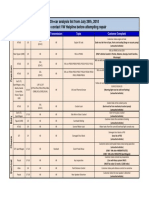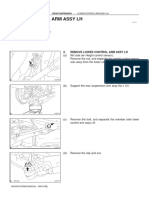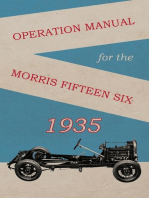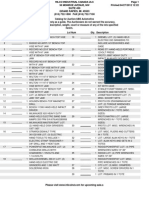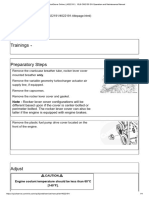Technical Bulletin #266: Updates
Technical Bulletin #266: Updates
Uploaded by
Juan IdrovoCopyright:
Available Formats
Technical Bulletin #266: Updates
Technical Bulletin #266: Updates
Uploaded by
Juan IdrovoOriginal Title
Copyright
Available Formats
Share this document
Did you find this document useful?
Is this content inappropriate?
Copyright:
Available Formats
Technical Bulletin #266: Updates
Technical Bulletin #266: Updates
Uploaded by
Juan IdrovoCopyright:
Available Formats
Technical Bulletin #266
Transmission: 4L80E
Subject: Updates
Application: Chevrolet
Issue Date: 1995
4L80E 4L80E
Updates Updates
Many electrical changes have occurred in the 4L80E colored exterior. Internally, the solenoids vary greatly.
transmission for the 1994 model year, these include: The size of the spool valve has been increased and a
spring was added to eliminate the need for the 10-sec-
• A new pressure control solenoid. ond cleaning pulse. (Figure 1)
• New shift solenoids, A&B.
• A new wiring harness and connector. To accommodate this change, the oil channeling for
• Changes in vehicle speed sensor the solenoid has been changed. This change removes
circuitry and components. the balance oil from the end of the solenoid, which
• Addition of a 4WD switch on all 4WD means the Bosch unit must not be used to replace a
models. Holley solenoid or high line pressure will result. In
• New codes for transmission faults. addition, the resistance of the new solenoid is slightly
• APP sensor was added. higher at 3-8W . With this slight increase in resistance,
you will notice the duty cycle reading on your scanner
Pressure Control Solenoid or meter is also slightly higher while the
Beginning with the start of production for the 1994 amperage/pressure values remain the same as the
model year all 4L80E models were equipped with a Bosch Units. The duty cycle values for the Holley will
new designed pressure control solenoid (force motor). normally read about 50 to 70% at idle and decrease as
1991-93 model units were equipped with a unit built load is increased.
by Bosch, which can be identified by its silver colored
exterior. The new pressure control solenoid is manu-
factured by Holley and can be identified by its black
ARMATURE ASM ACTUATOR TORQUE EXHAUST VARIABLE ARMATURE SPRING FRAME
FEED SIGNAL BLEED
HOUSING LIMIT FLUID ORIFICE
COIL ASM FLUID
VALVE
SPOOL
VALVE SPOOL
SPRING VALVE
INTEGRAL FILTERS PUSH
SPOOL
TERMINALS ROD
FLUID VALVE DAMPER COIL
SCREENS SLEEVE SPRING RESTRICTOR ASSEMBLY
REGULATING SPRING
Busch 1991-93 Holley 1994-95
Bosch pcs GM part number 8677314 Figure 1 Holley pcs GM part number 8684216
Copyright © 2003 ATRA. All Rights Reserved. ! Page 1 of 7
Technical Bulletin #266
Shift Solenoids A (1-2) B (2-3) New Wiring Harness Connector
In November 1993 (94 models), all 4L80E transmis- To reduce the possibility of leakage and multiple code
sions were equipped with updated shift solenoids. This storage a new connector was added to all 4L80E mod-
third design solenoid change is identified by new color els. (Figure 2).
codes.
First design, solenoid ‘A’-BLUE, solenoid ‘B’-RED
Second design, solenoid ‘A’-GRAY, solenoid ‘B’-
GREEN
Third design, solenoid ‘A’-PURPLE, solenoid ‘B’-
TAN
This update was made to increase solenoid reliability.
The updated solenoids can be used on any model year
4L80E unit. Third design GM part numbers: Solenoid
‘A’ 24201004, solenoid ‘B’ 24201005.
(C) +12V SHIFT SOLENOIDS-RED CAVITY
(D) PSM-BLACK
(E) PSM-WHITE A 1-2 Shift Solenoid Control Circuit
(B)
SOLENOID “B” GROUND-GREEN (F) PSM-BLUE
(A) SOLENOID “A” GROUND-BLUE
B 2-3 Shift Solenoid Control Circuit
C Pressure Control Solenoid (High)
(H) +5V TEMP. SENSOR-RED
(G) TEMP. SENSOR GROUND-GREEN D Pressure Control Solenoid (Low)
(M) FORCE MOTOR-GREEN
(L) FORCE MOTOR-BLUE F Both Shift Solenoids, TCC Solenoid, Ignition (B+) Feed Circuit
(K) 12V PWM SOLENOID-WHITE
(J) PWM SOLENOID GROUND-BLACK L Transmission Fluid Temperature (TFT) Signal Circuit
M Transmission Fluid Temperature (TFT) Sensor Ground Cirtuit
N Range Signal ‘A’ Circuit
T
P Range Signal ‘C’ Circuit
S R P N M L
R Range Signal ‘B’ Cirtuit
E
S TCC PWM Soleniod Control Circuit
D C B A
Figure 2
! Page 2 of 7 Copyright © 2003 ATRA. All Rights Reserved.
Technical Bulletin #266
Vehicle Speed sensor Circuits If the wrong transmission part number or a carrier unit
As of start of production 1994, all 4L80E models without a toothed wheel is installed in a 1991-93 vehi-
underwent changes to their vehicle speed wiring cir- cle, late/no upshifts may result.
cuits. These changes included dropping the transmis-
sion output speed sensor and toothed wheel on 4WD NOTE: Late upshifts may result due to the sensor
units, as well as significant wiring and circuit changes picking up a 21 pulse peer rotation signal from the
in 2WD and 4WD applications. machined slots cut in the output planetary assembly,
rather than the normal 40 pulse per rotation signal the
All 4WD units now use only output speed sensor PCM/TCM experts to see.
(located at the transfer case) rather than sensors at the
transfer case and the transmission output shaft. Since Both 1994-95 4WD and 2WD vehicles use the same
the output toothed wheel was also dropped (Figure 3), wiring layouts for their output vehicle speed sensor
care must be taken not to interchange output planetary circuits. (Figure 4)
carrier assembles between output VSS and non output
VSS equipped units. Attention must also be given
when replacing a unit with a rebuilt transmission to
assure the transmission is properly equipped with or
without a toothed sensor wheel.
Figure 3
VSS SIGNAL BUFFER MODULE
C7 VSS INPUT C7 822 LT GRN/BLK B VEHICLE
2000
C8 PULSES SPEED SENSOR
A (VSS)
PER C12 821 PPL
C9 VSS INPUT
MILE
C10
IGNITION IGNITION
C11
FEED
C9
SWITCH PCM
VSS
C12 BUFFER
MODULE C10
C13
C14 TRANS OUTPUT C13 437 BRN F12 5V
40 SPEED OUTPUT SPEED SIGNAL
C15
PULSES 1697 F13
PER REV VSS OUTPUT C11 5V
VSS BUFFER VEHICLE SPEED SIGNAL
824 LT BLU/BLK TO
HARNESS VSS OUTPUT C15
CONNECTOR SPEEDO
(FRONT VIEW) C8 TO 4WD F8 12V
GROUND
ENGINE INDICATOR 4WD LOW SIGNAL
GROUNDS SWITCH
Figure 4
Copyright © 2003 ATRA. All Rights Reserved. ! Page 3 of 7
Technical Bulletin #266
4 Wheel Drive Circuit During ranges other than LOW, the switch remains
In conjunction with the VSS circuit changes, all 2994- open and the PCM feed circuit 1493 remains at battery
95 4L80E 4WD applications have added an additional voltage.
switch as an input to the PCM. This switch (and its
circuit) eliminates the need to use a transmission out- As the Low range is selected, the transfer case switch
put speed sensor and a transfer case speed sensor to grounds circuit 1493. This pulls the signal voltage at
determine when the vehicle was placed in 4WD LOW the PCM low and signals the PCM to change the vehi-
range as on 1991-93 vehicles. cle up/down shift points to accommodate the change to
4WD LOW range. 4WD LOW switch position is indi-
As previously mentioned, the transmission output cated as a scan tool parameter on 94-95 vehicles.
speed sensor has been dropped from all 94-95 4WD
models. 4WD LOW range is now determined by moni-
toring a circuit designed exclusively for that purpose.
To accomplish this, the switch at the back of the trans-
fer case, which was used to energize the front drive
axle thermal actuator, has an additional set of contacts
and an additional wire which signals the PCM when
the 4WD LOW range is selected. (Figure 5)
Figure 5
! Page 4 of 7 Copyright © 2003 ATRA. All Rights Reserved.
Technical Bulletin #266
Additional Codes CODE 72 - VSS Signal Loss Parameters:
6-17 new diagnostic trouble codes were added for Code 28 is not set.
1995 models. Engine running, transmission indicates a forward or
reverse range has been selected.
CODE 37 - Brake Switch Stuck ON Parameters: Output sensor signal changes by 1000 rpm or more
• PCM receives an input signal of 0 volts from the within two seconds.
brake switch circuit.
• Vehicle speed was less than 5mph then rises to more or
than 20mph, time interval of more than 6 seconds is
met at each step. Code 28 is not set.
• The above conditions are repeated 7 times. Engine running, transmission indicates neutral or park
range has been selected.
CODE 38 - Brake Switch Stuck OFF Parameters: Output sensor signal changes by 2050 rpm or more
• Brake switch circuit input to the PCM indicates within two seconds.
battery voltage all the time. If code 72 sets, the PCM will respond by:
• Vehicle speed exceeds 20mph then drops to less than Commanding second gear only.
5mph; time interval of six seconds or more is met at Commanding line pressure to maximum.
each step.
• The above conditions were repeated seven times. CODE 74 - Input Speed Sensor Parameters:
If code 37 or 38 sets the PCM will respond by: Codes 24 or 28 are not set.
• Inhibiting TCC. Forward or reverse ranges indicated.
• Inhibiting fourth gear in hot mode. Engine is running.
Output speed greater than 200 rpm.
CODE 69 - TCC Stuck ON Parameters: Input speed sensor indicates less than 50 rpm for more
No codes 21,22,28,74 are set. than two seconds.
TCC slip indicates TCC is ON. If code 74 sets, the PCM will respond by:
TCC is commanded OFF. Inhibiting TCC.
TP sensor indicates load greater than 25%.
D-4 or D-3 range is indicated. CODE 79 - Transmission Fluid Overtemp Parameters:
PCM commands unit to second or third gears. Code 58 is not set.
The above conditions are present for more than two Fluid temperature indicates above 146° C, 295° F for
seconds. more than 30 minutes.
NOTE: No PCM default actions are taken for code NOTE: No default actions will be present for code 79.
69.
Copyright © 2003 ATRA. All Rights Reserved. ! Page 5 of 7
Technical Bulletin #266
Accelerator Pedal Position Sensor
The 6.5 liter electronic fuel injected diesel engine was APP #1 reads approximately .5 volts at idle and
introduced as a replacement for the 6.2 liter diesel in climbs steadily to approximately 4.0-4.25 volts at wide
most applications. This engine touts a technology open throttle.
never before seen in the GM light duty line, drive by
wire. Instead of using a throttle cable to control the APP #2 will produce a signal of approximately 4.5
injector pump, the 6.5L EFI uses a pod of throttle posi- volts at idle and decrease steadily to about 1.25 volts
tion sensors known as an accelerator pedal position or less at wide open throttle.
sensor (APP).
APP #3 provides a signal of approximately 4 volts at
The APP sensor is mounted inside the passenger com- idle which decreases steadily to approximately 2.25-
partment and has the accelerator pedal attached to it. 2.0 volts at wide open throttle. (Figure 8)
(Figure 6)
AP
P2
AP
P2
FULL THROTTLE
FULL TRAVEL
P1
AP
Figure 6
0 100
The APP sensor houses three potentiometers which are
used to measure the percentage of throttle opening. Figure 8
(Figure 7)
Figure 7
! Page 6 of 7 Copyright © 2003 ATRA. All Rights Reserved.
Technical Bulletin #266
Eleven different trouble codes are used to describe Code 67- APP sensor 3 indicates more than 6% differ-
problems within the APP sensor or circuits. ence when compared to sensor #2.
Malfunctions within the APP sensor/circuit may have
dramatic effects on how well the transmission per- Code 84-Indicates and intermittent fault exists. This
forms since the sensor acts as the load input to the code will only set if no other APP sensor codes are set.
PCM. The codes are: This code can set if codes 17, 18, 19, 34, 35 or 36 are
set. If code 84 is set in conjunction with any of the
Code 21-APP sensor #1 voltage greater than 4.75 volts above codes it is most likely a false code.
for 2 seconds or more.
Code 99- APP sensor #2 reference voltage less than
Code 22-APP sensor #1 voltage less than .25 for 2 4.8 volts for 2 seconds.
seconds or more.
Many different transmission default actions can occur
Code 23-APP sensor #1 indicates more than 6% dif- if any of the previous codes are to set. In addition,
ference from sensor #2 and a 10% difference when other driveability symptoms may also result such as:
compared to sensor #3.
#1 APP sensors faulty, no service throttle light,
Code 25-APP sensor #2 voltage greater than 4.75 volts reduced power and poor throttle response.
for 2 seconds or more.
#2 APP sensor faulty, service throttle soon light on,
Code 26-APP sensor #2 voltage less than .25 volts for reduced power, limited to about 50%. Some #2 codes
2 seconds or more. will result in the engine dropping back to curb idle
when throttle is above 5% and the brake is applied.
Code 27-APP sensor #2 indicates more than 6% dif-
ference from #1 and a 10% difference when compared #3 APP sensor faulty, service throttle soon light on,
to sensor #3. idle fuel delivery available only, which leads to a
major lack of power complaint. (Some scan tools can
Code 63-App sensor #3 voltage greater than 4.75 volts be used to override this fault so the vehicle may be
for 2 seconds or more. driven to the repair facility.)
Code 64-APP sensor #3 voltage less than .25 volts for
2 seconds or more.
Copyright © 2003 ATRA. All Rights Reserved. ! Page 7 of 7
You might also like
- D6E Engine PDFDocument387 pagesD6E Engine PDFLinzaw Oo94% (16)
- WP45LDocument158 pagesWP45Ljohn smith100% (3)
- Asm Vr115hvDocument104 pagesAsm Vr115hvDaniel Alex Sánchez78% (9)
- Jeep Cherokee 2014Document31 pagesJeep Cherokee 2014InnNo ratings yet
- GS200 ManualDocument29 pagesGS200 ManualDuvel Arago50% (2)
- A 750e PDFDocument100 pagesA 750e PDFTaymazNo ratings yet
- SECTION 204-01: Front Suspension 2013 Explorer Workshop Manual Removal and InstallationDocument4 pagesSECTION 204-01: Front Suspension 2013 Explorer Workshop Manual Removal and InstallationPaul SegarraNo ratings yet
- HPA 2.0T FSI Intake Manifold IsheetDocument16 pagesHPA 2.0T FSI Intake Manifold IsheetRyan_Jacobs9439100% (1)
- VW Q1 2015 Obd Ii Cal Id and CVN Data: o Ri NDocument5 pagesVW Q1 2015 Obd Ii Cal Id and CVN Data: o Ri NAdrianBalaNo ratings yet
- Technical Bulletin: ConditionDocument4 pagesTechnical Bulletin: ConditionKarim Elmahroky100% (1)
- R4a51 - V4a51 - R5a51 - V5a51 PDFDocument4 pagesR4a51 - V4a51 - R5a51 - V5a51 PDFJuan Idrovo100% (1)
- "Transmission Drive Pump Pressure Override Calibration": Illustration 1 g02500239 Cat ET Calibrations MenuDocument6 pages"Transmission Drive Pump Pressure Override Calibration": Illustration 1 g02500239 Cat ET Calibrations MenuNurdin50% (2)
- Gek 46508Document8 pagesGek 46508Ganeshmohite123No ratings yet
- Product Spotlight: HONDA "BAXA," Civics & Accords, '96-Up Solenoid Adjustment ToolDocument7 pagesProduct Spotlight: HONDA "BAXA," Civics & Accords, '96-Up Solenoid Adjustment ToolAlejandro Gomez100% (1)
- VW - tb.20!08!02 RVU - Fuel Pressure Sensor ReplacementDocument5 pagesVW - tb.20!08!02 RVU - Fuel Pressure Sensor ReplacementFabian Alejandro Morales MedinaNo ratings yet
- 1993 Chevrolet Pickup C1500 Fig. 30: 7.4L (VIN N), Transmission Circuit, 4L80-EDocument1 page1993 Chevrolet Pickup C1500 Fig. 30: 7.4L (VIN N), Transmission Circuit, 4L80-Eahm5514100% (1)
- Report TSBDocument4 pagesReport TSBJM BNo ratings yet
- K0059220020-Basic Equipment From March 2013Document1,710 pagesK0059220020-Basic Equipment From March 2013Russ HoweNo ratings yet
- VW - tb.15!05!01 Oil Leaks From Upper Engine Area DiagnosisDocument5 pagesVW - tb.15!05!01 Oil Leaks From Upper Engine Area DiagnosisSlobodan100% (1)
- SM 7 PDFDocument144 pagesSM 7 PDFRoberto Lara MartínezNo ratings yet
- JX 250 1D Man PDFDocument72 pagesJX 250 1D Man PDFJulio Cesar Mendoza PazNo ratings yet
- Carbureted and Ramjet Auto Transmission Control System PDFDocument12 pagesCarbureted and Ramjet Auto Transmission Control System PDFAmor MansouriNo ratings yet
- Fusible JettaDocument2 pagesFusible JettazahirronNo ratings yet
- J-38125-620B Terminal Repair BookletDocument72 pagesJ-38125-620B Terminal Repair BookletMarc Quelle100% (1)
- Four Wheel Drive (4WD) Controls - TaggedDocument40 pagesFour Wheel Drive (4WD) Controls - TaggedNatty NuggetNo ratings yet
- Pioneer Automotive - Powertrain FRC-2011Document744 pagesPioneer Automotive - Powertrain FRC-2011scribdfourmeNo ratings yet
- 182 185Document4 pages182 185jharl100% (2)
- 21 - Turbocharging/supercharging: 1 Exhaust TurbochargerDocument35 pages21 - Turbocharging/supercharging: 1 Exhaust TurbochargerRoberto Lara Martínez100% (1)
- 8 BodyDocument234 pages8 BodyAlekos Ntinopoulos0% (2)
- VW B6 Passat Ziza Interior LED Light DIYDocument10 pagesVW B6 Passat Ziza Interior LED Light DIYNichole Reynolds100% (1)
- Running Gear, Axles, SteeringDocument373 pagesRunning Gear, Axles, SteeringCodiano Silva100% (1)
- Antilock BrakesDocument117 pagesAntilock BrakesNoel Alejandro Cordova Rangel100% (1)
- GM 2007 LD General InformationDocument37 pagesGM 2007 LD General InformationschraeubleNo ratings yet
- Brake Shoes Removal and Installation PDFDocument6 pagesBrake Shoes Removal and Installation PDFMichael HernandezNo ratings yet
- Manual Explorer PDFDocument296 pagesManual Explorer PDFCarolina Desirée DiazNo ratings yet
- BM Shifth 6l60Document12 pagesBM Shifth 6l60Anonymous WzR5h9g8V100% (1)
- On-Car Analysis List From July 26th, 2018 Please Contact VW Helpline Before Attempting RepairDocument1 pageOn-Car Analysis List From July 26th, 2018 Please Contact VW Helpline Before Attempting RepairOleksiy OsiychukNo ratings yet
- JPAT Converter GuideDocument37 pagesJPAT Converter Guideสัญญา สุรเมธีNo ratings yet
- Electronic Stability Program (ESP) Hydraulic Unit, ServicingDocument18 pagesElectronic Stability Program (ESP) Hydraulic Unit, ServicingIonut NutzuNo ratings yet
- ls9 Crate Engine Control System 19354338Document40 pagesls9 Crate Engine Control System 19354338Sebastian OlayaNo ratings yet
- VW Eos Maintenance PDFDocument75 pagesVW Eos Maintenance PDFNick P100% (1)
- LS9 Crate Engine 19244099Document17 pagesLS9 Crate Engine 19244099Karanveer SinghNo ratings yet
- 2023 Silverado1500Document463 pages2023 Silverado1500samuel dionNo ratings yet
- Rear Suspension PDFDocument30 pagesRear Suspension PDFtavi2me100% (1)
- 1995 GMC Yukon SuburbanDocument492 pages1995 GMC Yukon SuburbanJeswil HernandezNo ratings yet
- Jetta A5 January 2010Document10 pagesJetta A5 January 2010billydump100% (1)
- 2011 White 108Document1 page2011 White 108Balo ChaconNo ratings yet
- 2016 TahoeDocument453 pages2016 TahoeMartin StangeNo ratings yet
- Precision 6T70 Parts Catalog 2024Document4 pagesPrecision 6T70 Parts Catalog 2024Альфир АптикаевNo ratings yet
- 1996-97 Auto Trans ServiceDocument6 pages1996-97 Auto Trans ServiceFSR1407No ratings yet
- GM TechLink 11 June 2021Document9 pagesGM TechLink 11 June 2021akppdetoli100% (1)
- ETKA VW Jetta 2006 Front Bumper PartNumbersDocument3 pagesETKA VW Jetta 2006 Front Bumper PartNumbersangeltavNo ratings yet
- 44re DodgeDocument1 page44re DodgeAlonso IbarraNo ratings yet
- SM 37 PDFDocument233 pagesSM 37 PDFEdin EleziNo ratings yet
- 4L30E Boletin de Servicio.Document4 pages4L30E Boletin de Servicio.Cynthia HuntNo ratings yet
- Replacement Parts Catalog: Automatic TransmissionDocument180 pagesReplacement Parts Catalog: Automatic TransmissionCarlos HT Tmberto Tranamil Barros100% (2)
- Intake Manifold/Upper Engine: 2009 Pontiac G8 G8 Service ManualDocument13 pagesIntake Manifold/Upper Engine: 2009 Pontiac G8 G8 Service ManualjaumegusNo ratings yet
- 25 g4 Standard Eq 2Document19 pages25 g4 Standard Eq 2Ovidiu BruzanNo ratings yet
- W8 Cluster How To PDFDocument15 pagesW8 Cluster How To PDFCarlosZavalaNo ratings yet
- 2005 KJ Transmission DSLDocument244 pages2005 KJ Transmission DSLmock_er100% (2)
- Beetle January 2005Document23 pagesBeetle January 2005Caroline PuckettNo ratings yet
- How to Modify Your Mopar Magnum V-8HP1473: A Step-by-Step Guide to Modifying Magnum Series Engines for High Performance Street and Racing ApplicationsFrom EverandHow to Modify Your Mopar Magnum V-8HP1473: A Step-by-Step Guide to Modifying Magnum Series Engines for High Performance Street and Racing ApplicationsNo ratings yet
- Bell-Housing - Coupling UKDocument78 pagesBell-Housing - Coupling UKtoshi sugaharaNo ratings yet
- D 631 Series ValvesDocument12 pagesD 631 Series ValvesNo PromisesNo ratings yet
- BE Spec Flash EconomizerDocument4 pagesBE Spec Flash Economizeronkarrathee100% (1)
- Gr00003000a 23a PDFDocument176 pagesGr00003000a 23a PDFJuan IdrovoNo ratings yet
- Millard Catalog EuropeDocument136 pagesMillard Catalog EuropeJuan IdrovoNo ratings yet
- 4L80E (MT-1), 4L85E (MN8) : 4 SPEED RWD (Electronic Control)Document6 pages4L80E (MT-1), 4L85E (MN8) : 4 SPEED RWD (Electronic Control)Juan IdrovoNo ratings yet
- GM 4L60E and 4L80E: B&M Part Numbers: 117308 - 117309 118001 - 118002 - 118003Document5 pagesGM 4L60E and 4L80E: B&M Part Numbers: 117308 - 117309 118001 - 118002 - 118003Juan IdrovoNo ratings yet
- GEN3 Powertrain Controller Transmission Control User's ManualDocument22 pagesGEN3 Powertrain Controller Transmission Control User's ManualJuan Idrovo100% (1)
- Gr00003000a 23a PDFDocument176 pagesGr00003000a 23a PDFJuan IdrovoNo ratings yet
- CX7P9 Calefaccion PDFDocument92 pagesCX7P9 Calefaccion PDFJuan IdrovoNo ratings yet
- CX7P9 Calefaccion PDFDocument92 pagesCX7P9 Calefaccion PDFJuan IdrovoNo ratings yet
- Mazda l3 With TC Engine Workshop Manual PDFDocument70 pagesMazda l3 With TC Engine Workshop Manual PDFJuan Idrovo100% (1)
- Datos Vehiculos 2020Document3 pagesDatos Vehiculos 2020Juan IdrovoNo ratings yet
- Stonel Limit Switch InstructionsDocument2 pagesStonel Limit Switch InstructionsgenibraNo ratings yet
- Ed WP Automatic Commutation of Stepper MotorsDocument9 pagesEd WP Automatic Commutation of Stepper MotorsSelfiana UlfaNo ratings yet
- FMF-01-10-911-304 - 200 GPM - 60 HZ Electric Motor DriveDocument1 pageFMF-01-10-911-304 - 200 GPM - 60 HZ Electric Motor DriveMarkNo ratings yet
- Volkswagen New Beetle Brake System ABS, ABS/EDLDocument43 pagesVolkswagen New Beetle Brake System ABS, ABS/EDLRicardo AlemaoNo ratings yet
- Load DiagramDocument26 pagesLoad DiagramnareshNo ratings yet
- Price List - 2013Document11 pagesPrice List - 2013John MaNo ratings yet
- Bosch Powerpack-BrochureDocument16 pagesBosch Powerpack-BrochurengazawooNo ratings yet
- C300 (KORANDO) II - Engine (D16DTF) New VersionDocument197 pagesC300 (KORANDO) II - Engine (D16DTF) New Versionm.gavrielNo ratings yet
- Keyway, Key Details: High TypeDocument1 pageKeyway, Key Details: High TypeJuan carlos Calzado AlmansaNo ratings yet
- XAHS-486E Parts ManualDocument94 pagesXAHS-486E Parts ManualChester Dalitso Mwanza100% (2)
- Manual: Original Instructions Ver ADocument70 pagesManual: Original Instructions Ver AEdward Erney Salas ValenzuelaNo ratings yet
- 99717Document6 pages99717Miguel RojasNo ratings yet
- European Catalog Asia Pacific Express Asco en 5041722Document70 pagesEuropean Catalog Asia Pacific Express Asco en 5041722treborNo ratings yet
- RP JohnDeere Waterpump 6135HDocument2 pagesRP JohnDeere Waterpump 6135HLuis Alberto AnguianoNo ratings yet
- Anexo D E.T. v80-2mw-2Document14 pagesAnexo D E.T. v80-2mw-2riogad100% (1)
- All About Marine Enginnering OralsDocument76 pagesAll About Marine Enginnering OralsUdana Hettiarachchi100% (3)
- Cutter Section: 1. Theory of OperationDocument8 pagesCutter Section: 1. Theory of OperationRheana DomingoNo ratings yet
- 797f m02 Vims enDocument39 pages797f m02 Vims enEdin Raul Yalle RafaelNo ratings yet
- UBE Automotive Lot CatalogDocument28 pagesUBE Automotive Lot CatalogQuan Huynh50% (2)
- Governing 11Document35 pagesGoverning 11rahul100% (3)
- Milling GuidelinesDocument13 pagesMilling Guidelinesazert511No ratings yet
- Automotive Chassis and Suspension by M A QadeerDocument120 pagesAutomotive Chassis and Suspension by M A QadeerAbdul Qadeer Siddiqui100% (5)
- 003-004 Overhead SetDocument4 pages003-004 Overhead SetWaleed OmdaNo ratings yet
- 800 Manual de Servicio PDFDocument402 pages800 Manual de Servicio PDFmarcol705No ratings yet




































